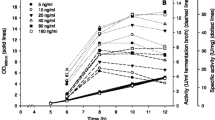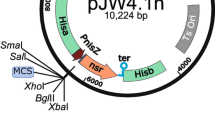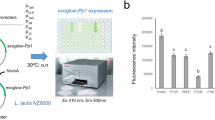Abstract
Recombinant Lactococcus lactis MG1363/pMG36e-lacZ exhibiting high β-galactosidase activities were constructed by us in the previous study. However, erythromycin resistance present in these recombinants restricted their practical application in food preparation. This study was conducted to delete the gene coding for erythromycin resistance present in recombinant L. lactis, as a result of which these bacteria express food-grade β-galactosidase. In this study, the recombinant plasmid pMG36e-lacZ was digested with restriction enzymes BclI and HpaI and the food-grade plasmid FGZW was rebuilt. FGZW was transformed into Escherichia coli JM109 and L. lactis MG1363. Erythromycin resistance, enzyme activity determination, gene sequencing and SDS-PAGE analysis indicated that these new recombinant bacteria lost erythromycin resistance and its relevant gene but still expressed β-galactosidase activities, although a decrease in the expression of β-galactosidase of these new strains was observed. The β-galactosidase food-grade expression system was successfully constructed and it could provide a new solution for the management of lactose intolerance. These results might promote the usage of gene-modified microorganisms and related technology in the food sector, which has the highest priority for food safety.




Similar content being viewed by others
References
Heyman MB (2006) Lactose intolerance in infants, children, and adolescents. Comm Nutr Pediatr 118:1279–1286
He M, Yang YX (1999) Lactase deficiency and lactose intolerance. Foreign Med Sci Hyg 6:339–342
Poulter M, Hollox E, Harvey CB et al (2003) The causal element for the lactase persistence/non-persistence polymorphism is located in a 1 Mb region of linkage disequilibrium in Europeans. Ann Hum Genet 67:298–311
Yang YX, He M, Cui HM et al (1999) Study on the incidence of lactose intolerance of children in China. J Hyg Res 28:44–46
Xu Y, Wu XY, Lu YQ et al (2008) Study on lactose intolerance. Acad Period Farm Prod Process 11:89–91
Gao YB (1997) How to resolve lactose intolerance. China Dairy Ind 25:40–42
Li W, Zhang XM, Lu Y et al (2004) Lactose intolerance and the development of low-lactose milk. China Dairy 2:35–37
Chang MH, Hsu HY, Chen CJ et al (1987) Lactose malabsorption and small-intestinal lactase in normal Chinese children. J Pediatr Gastroenterol Nutr 6:369–372
Scrimshawm NS, Murray EB (1988) The acceptability of milk and milk products in populations with a high prevalence of lactose intolerance. Am J Clin Nutr 48:1079–1159
Zhong Y (2003) Probiotic and the study of the lactose intolerance. Foreign Med Sci Hyg 2:101–105
Guo BH (2004) Probiotics. Chemical Industry Press, Beijing
Guo XH (2002) Fundamentals and applications of probiotics. Beijing Science and Technology Press, Beijing
Corthesy B, Boris S, Lsler P et al (2005) Oral immunization of mice with lactic acid bacteria producing Hdlicobacter pylori urease B subunit partially protects against challenge with Helicobacter felis. J Infect Dis 192:1441–1449
Xiao W, Zhang YZ (2008) Construction and identification of Lactobacillus casei food-graded system. Chin J Appl Environ Biol 14:566–570
Chuan W, Chao WZ, Heng CL et al (2008) Non-fusion and fusion expression of β-galactosidase from Lactobacillus Bulgaricus in Lactococcus lactis. Biomed Environ Sci 21:389–397
Wang C, Zhang CW, Pei XF et al (2007) Identification and phylogenetic analysis of one strain of Lactobacillus delbrueckii subsp. Bulgaricus separated from yoghourt. J Hyg Res 36:713–718
Ausubel FM, Brent R, Kingston RE et al (2002) In: Jin YX, Bao HZ, Zhao LY (eds) Short protocols in molecular biology, 5th edn. Wiley, New York, pp 17–23
Jia SF, Wang YY, Guo XH et al (1998) Study of electroporation processing of Lactobacilli. Chin J Biotechnol 14:429–433
Xia ZF, Shi GY, Zang L et al (2008) Optimization of electroporation processing of Lactobacilli. Food Sci 29:205–209
Shah N, Jelen P (1991) Lactose absorption by postweaning rats from yogurt, quarg, and quarg whey. J Dairy Sci 74:1512–1520
Stellmach B (1992) In: Qian JY (ed) Bestimmungsmethoden enzyme, 2nd edn. China Light Industry Press, Beijing, pp 195–201
Van de Guchte M, Van der Vossen JM, Kok J et al (1989) Construction of a lactococcal expression vector: expression of hen egg white lysozyme in Lactococcus lactis subsp. lactis. Appl Environ Microbiol 55:224–228
Van de Guchte M, Kodde J, Van der Vossen JM et al (1990) Heterologous gene expression in Lactococcus lactis subsp. lactis: synthesis, secretion, and processing of the Bacillus subtilis neutral protease. Appl Environ Microbiol 56:2602–2611
Platteeuw C, van Alen-Boerrigter I, van Schalkwijk S et al (1996) Food-grade cloning and expression system for Lactococcus lactis. Appl Environ Microbiol 62:1008–1013
Wang C, Zhang CW, Liu HC et al (2008) Optimizing the conditions of β-galactosidase producing and determining of enzyme activities of two strains of Lactobacillus bulgaricus. Chin J Microecol 18:161–163
Acknowledgments
This study was supported by funds from the National Science Foundation of China (Grant No. 30800910). We are grateful to Dr. Fang He, Takanashi Milk Products Co., Ltd for critical reading of the manuscript and helpful suggestions.
Author information
Authors and Affiliations
Corresponding authors
Rights and permissions
About this article
Cite this article
Zhang, W., Wang, C., Huang, C. et al. Construction and Expression of Food-Grade β-Galactosidase Gene in Lactococcus Lactis . Curr Microbiol 62, 639–644 (2011). https://doi.org/10.1007/s00284-010-9756-5
Received:
Accepted:
Published:
Issue Date:
DOI: https://doi.org/10.1007/s00284-010-9756-5




